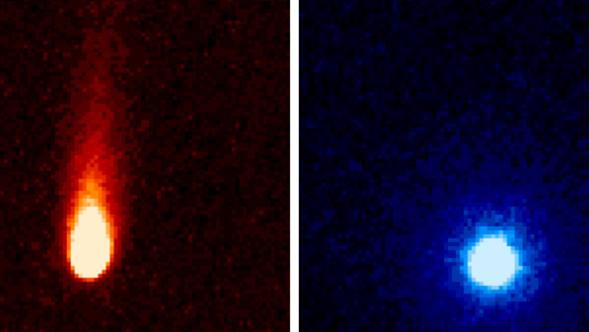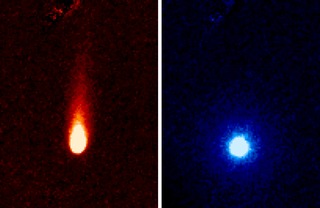
Credit: NASA/JPL-Caltech/JHUAPL/UCF
Observation • July 23rd, 2013 • ssc2013-06a
ssc2013-06a
These images from NASA's Spitzer Space Telescope of C/2012 S1 (Comet ISON) were taken on June 13, when ISON was 310 million miles (about 500 million kilometers) from the sun. The images were taken with the telescope's infrared array camera at two different near-infrared wavelengths, 3.6 and 4.5 microns (the representational colors shown were selected to enhance visibility). The 3.6-micron image on the left shows a tail of fine rocky dust issuing from the comet and blown back by the pressure of sunlight as the comet speeds towards the sun (the tail points away from the sun). The image on the right side shows the 4.5-micron image with the 3.6-micron image information (dust) removed, and reveals a very different round structure -- the first detection of a neutral gas atmosphere surrounding ISON. In this case, it is most likely created by carbon dioxide that is fizzing from the surface of the comet at a rate of about 2.2 million pounds (1 million kilograms) a day.
Comet ISON (officially known as C/2012 S1) is, like all comets, a dirty snowball made up of dust and frozen gases like water, ammonia, methane and carbon dioxide -- some of the fundamental building blocks that scientists believe led to the formation of the planets 4.5 billion years ago. ISON will pass within 724,000 miles (1.2 million kilometers) of the sun on Nov. 28, making it a sungrazer comet that will evaporate its ices and even its rocky dust near perihelion, revealing even more of the comets composition.
NASA is bringing to bear a vast fleet of spacecraft, instruments, and space- and Earth-based telescopes to study this rarely-seen type of comet over the next year. ISON stands for International Scientific Optical Network, a group of observatories in ten countries who have organized to detect, monitor, and track objects in space. ISON is managed by the Keldysh Institute of Applied Mathematics, part of the Russian Academy of Sciences.
The complete list of observers is: C.M. Lisse, R.J. Vervack, and H.A. Weaver, Johns Hopkins University Applied Physics Laboratory; J.M. Bauer, Jet Propulsion Laboratory/Caltech; Y.R. Fernandez, University of Central Florida; M.S.P. Kelley, University of Maryland; M.M. Knight, Lowell Observatory; D. Hines, Space Telescope Science Institute; J-Y Li, Planetary Science Institute; W. Reach, USRA/SOFIA; M. L. Sitko, University of Cincinnati; P. A. Yanamandra-Fisher, SSI; K.J. Meech and J. Rayner, University of Hawaii.
About the Object
- Name
- Comet ISON • C/2012 S1
- Type
- Interplanetary Body > Comet
Color Mapping
| Band | Wavelength | Telescope |
| Infrared | 3.6 µm | Spitzer IRAC |
| Infrared | 4.5 µm | Spitzer IRAC |





